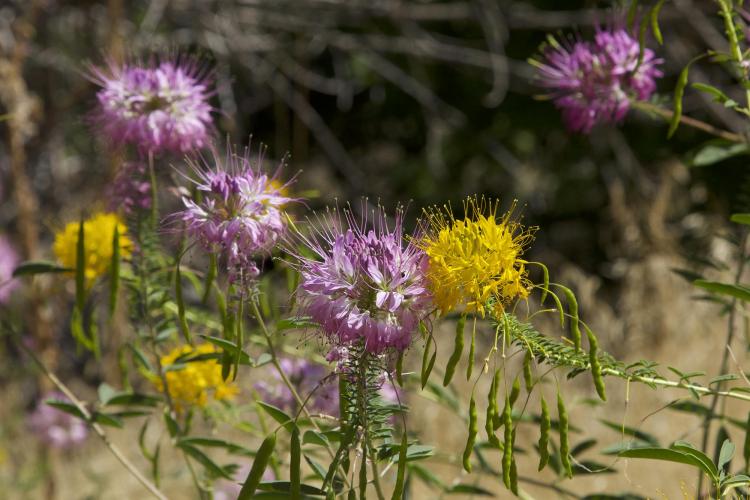Bee plants left their mark on Ancient Puebloan pottery
Bee plants in Colorado and on the Colorado plateau grow two to five feet tall, with many big, showy flowers. Rocky Mountain bee plant, Cleome serrulata, has magenta flowers and they occur frequently in roadside populations and in meadows. Yellow bee plant, Cleome lutea, grows well in alkaline sites, such as the banks of the Pariah River in the Grand Staircase of the Escalante in southern Utah. But I was treated to a stunning floral display when I found them growing together.
In late August I hiked to Mitten Park in Dinosaur National Monument to see the famous Mitten fault, where sedimentary lines in sandstone switch abruptly from horizontal to vertical and back again, all within 200 yards. The geology was grand, but a large, mixed stand of Rocky Mountain and yellow bee plants was also memorable.
The site was beside the Green River, perhaps 15 feet above the water, with somewhat alkaline soil with some white stains of salt. The plants grew well here, with many reaching heights of 4 to 5 feet and bearing many flowers.
Bee plant flowers are large globes approximately 2 inches in diameter, with 4 petals, 4 sepals, and 6 stems that reach far beyond the petals. Flowers are arranged in racemes at the ends of branches, with new flowers appearing for weeks during the summer. The fruits are pods called siliques containing a few to slightly over a dozen seeds. An individual plant produces both hermaphroditic flowers with both 6 anthers and a pistil, and staminate flowers with 6 stamens but lacking a pistil. Staminate flowers produce pollen but no seeds. In gardens, yellow bee plants produce an average of 11,000 seeds and Rocky Mountain bee plants produce an average of 26,000 seeds.
The flowers of these two species of bee plants open shortly after sunset, and within 1 to 3 hours they are secreting nectar and releasing pollen from the anthers. This timing of presentation of rewards for pollinators suggests that they are attracting nocturnal pollinators, which are typically hawkmoths or sphinx moths. But the papers on bee plants report that nocturnal pollinators have not been seen attending bee plants. It is strange that the flowers would start secreting nectar and releasing pollen 8 hours before dawn, when bees and wasps begin foraging. However, night vision glasses were used in a recent study to detect 5 species of night flying moths visiting Rocky Mountain bee plants.
A large diversity of insects visit bee plants during the day. I have seen a variety of butterflies, wasps and blister beetles. But the most diverse group of pollinators is native bees. In southern Utah, 140 species of native bees have been seen visiting yellow bee plants. Similar but less extensive studies found 62 bee species visiting Rocky Mountain bee plants.
As beautiful as they are, Rocky Mountain bee plants are known to be malodorous, inspiring other common names, including skunk weed and stink weed. The disagreeable smell is a methylglucosinolate, which is sufficiently repulsive to keep cows from consuming bee plants. This is the primary chemical defense that dissuades herbivorous insects from consuming leaves and stems.
Ancient Puebloans in the Four Corners area between 900 and 1,300 CE were known for their distinctive black on white pottery. The black pigment or dye has several sources, and Zuni, Keres and Tewa people obtained their black pottery paint from Rocky Mountain bee plants. They gathered large amounts of leaves and stems in late summer and boiled the plants in water. After the tougher parts were removed, the mass was boiled again until it became thick and black. They dried the dark material for storage. Later, the dark patties were softened with water and applied to pottery with a brush made of yucca fiber. Designs painted on pottery with bee plant paint are permanent, lasting many centuries.
I think that the Ancient Puebloans, who also used bee plants for food, would be pleased to know that today bee plants are grown commercially so their seeds can be used in restoration projects.


